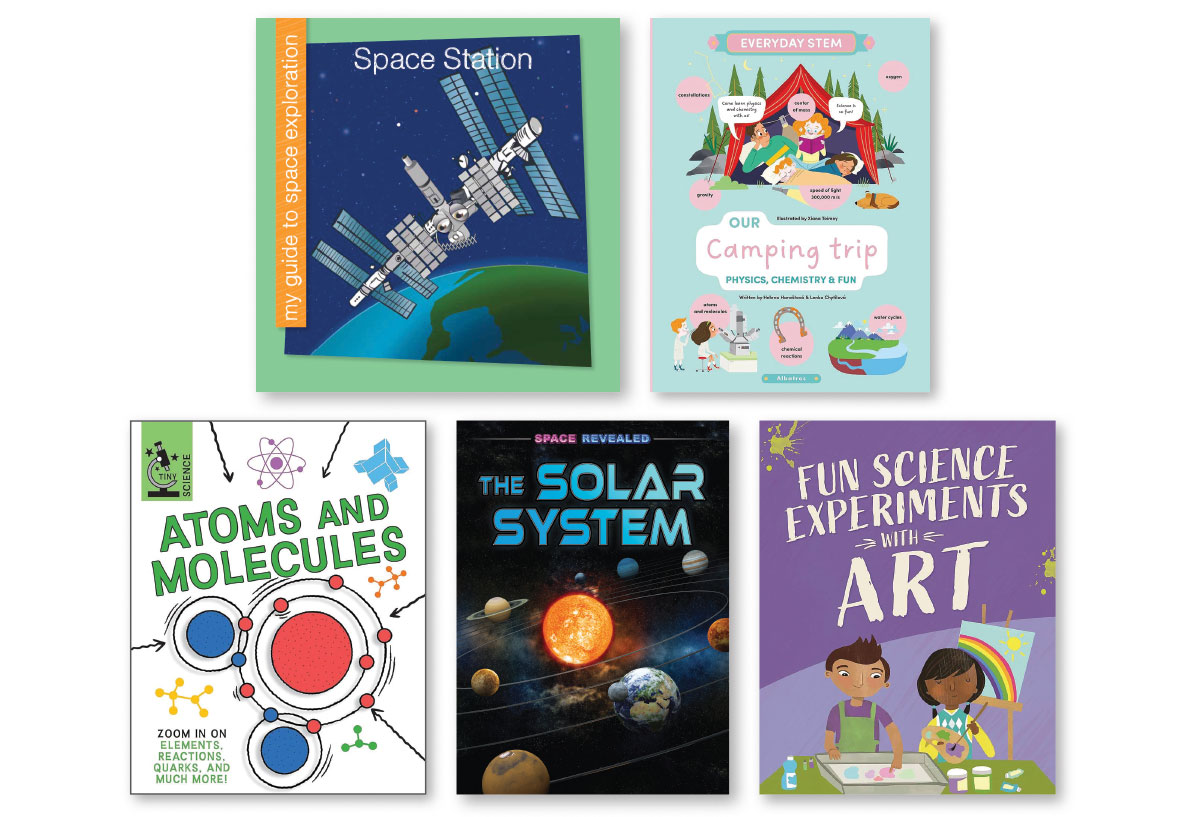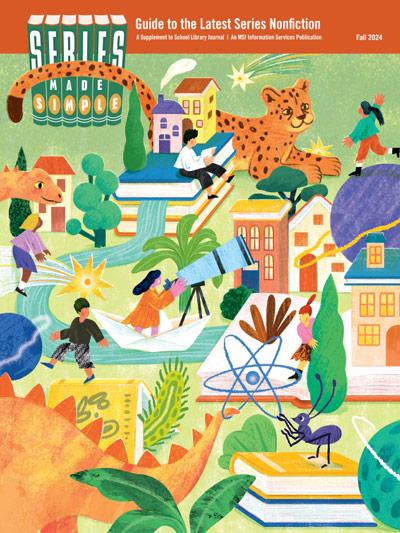It’s All Connected | General Science Series Nonfiction
From the reaches of outer space to the tiny world of nanobots, these science series will spark student interest.

Titles this season speak to student interests in a variety of ways. Some contain hands-on activities that highlight scientific principles in art, cooking, or gardening. Others delve into how everyday objects and systems function, whether it is the water cycle or how to put up a tent. The reaches of outer space and the tiny world of nanobots and quarks are explored, appealing to the love of the extremely large or small. Critical thinking questions and ideas to extend or personalize experiments help readers see connections to their own lives. The continuing work to diversify representation within photos and illustrations also encourages students to see themselves as part of the scientific community.
Elementary
Bell, Samantha. Astronaut. ISBN 9781668946565.
––––. Mission Control. ISBN 9781668946572.
––––. Rover. ISBN 9781668946589.
––––. Satellite. ISBN 9781668946596.
––––. Space Shuttle. ISBN 9781668946602.
––––. Space Station. ISBN 9781668946619.
––––. Space Suit. ISBN 9781668946626.
––––. Telescope. ISBN 9781668946633.
ea vol: illus. by Joseph Hatch. 24p. (My Guide to Space Exploration). Cherry Lake. Aug. 2024. Tr. $30.64.
K-Gr 2–In this early elementary series, information is presented through the viewpoint of the person, place, or piece of technology featured in the title. The rover explains that it uses its cameras to help it navigate, while the space telescope explains that it sees clearly without atmosphere to blur the images. Short, direct sentences are paired with large photos to share information. Cartoon-style illustrations pose questions that encourage readers to think critically about what they have read. For instance, the space suit mentions that each of its layers has a job. Then the illustration asks readers, “Do you ever have to wear layers?” A glossary supports comprehension and offers pronunciation for unfamiliar words and an index helps to locate information. VERDICT A good choice for primary grades with its unique approach to a high-interest topic.
ChytilovÁ, Lenka & Helena Haraštová. Our Camping Trip: Physics, Chemistry, and Fun. Bk. 1. ISBN 9788000072852.
––––. Planning Grandma’s Party: Measurements, Fractions, and Fun. Bk. 2. ISBN 9788000072869.
ea vol: tr. from Czech. illus. by Xiana Teimoy. 32p. (Everyday STEM). Albatros. Sept. 2024. Tr. $16.95.
Gr 2-4–These titles feature the Bright family (mom, dad, son, and daughter), as they encounter STEM topics during their everyday activities. Each spread focuses on a question that the kids might ask. For instance, as they go camping, they wonder “What’s the weather going to be like?” Other topics that come up include how to filter water and where the sun goes at night. Discussions about fractions, symmetry, and forms of measurement come up as they plan a birthday party for Grandma. Each question is followed by an explanation, observation or comparison, and an additional point or even suggestions to “Try It Yourself.” Cartoonish illustrations capture the family in action. Diagrams, charts, and other visuals further support the text. To help extend the learning there is a suggested reading list and a “Learning Check” with five review questions. VERDICT A relatable way to introduce STEM content to young science learners.
Leatherland, Noah. How Instruments Make Music. ISBN 9781534546752.
––––. How Our Ears Hear. ISBN 9781534546783.
––––. Measuring Sound. ISBN 9781534546813.
––––. Sonar. ISBN 9781534546844.
ea vol: 24p. (The Science of Sound). Greenhaven/KidHaven Publishing. Jul. 2024. Tr. $26.23.
Gr 1-3–Titles in this series cover everything from how various musical instruments produce sounds, to how we measure volume and pitch, to how different hearing aids work. Pages resemble a lab notebook with images taped inside and text added on bits of graph paper. Small text boxes offer additional details such as, “A bee’s buzz comes from its wings vibrating.” A chart compares various ratings on the decibel scale while diagrams also support the text by showing the ear’s structure or distinguishing between active and passive sonar. Some images also have labels. Glossary words appear in eye-catching color within the text for easy identification. A table of contents and an index are also provided. VERDICT A useful series for STEAM lessons, particularly the title on musical instruments, and also good for discussing types of waves and their applications.
Upper Elementary toMiddle School
Claybourne, Anna. Atoms and Molecules. ISBN 9781538294062.
––––. Cells. ISBN 9781538294093.
––––. Genes and DNA. ISBN 9781538294123.
––––. Germs. ISBN 9781538294154.
––––. Microscopic Creatures. ISBN 9781538294185.
––––. Nanotechnology. ISBN 9781538294215.
ea vol: 32p. (Tiny Science). Gareth Stevens. Aug. 2024. Tr. $28.27.
Gr 4-6–This series invites readers to “zoom in” on the smallest items of scientific interest, such as quarks, bacteria, and even tardigrades. Text is broken into chunks with headings, color backgrounds, and plentiful illustrations, diagrams, and occasional photos. A variety of characters comment on the concepts being discussed. Sometimes the comments are funny, such as one hydrogen atom telling another, “Let’s be friends!” as they form a molecule. Readers are encouraged to try related activities at home, like pond dipping and observing water under a microscope. Timelines trace the development of theories and breakthroughs related to atoms, genes, and nanotechnology. Each book ends by comparing the sizes of the various objects or creatures to a human hair. VERDICT A series sure to appeal to budding scientists, those who are fascinated by tiny things, and readers who enjoy a dose of humor with their nonfiction.
Martin, Claudia. Earth & the Moon. ISBN 9798892320788.
––––. The Solar System. ISBN 9798892320795.
––––. Space Exploration. ISBN 9798892320801.
––––. Stars & Galaxies. ISBN 9798892320818.
ea vol: 48p. (Space Revealed). Bearport/Ursa Books. Aug. 2024. Tr. $22.95.
Gr 5-8–The books in this striking series balance a page of text with either a large-scale image, several smaller images, or a diagrams depicting the information presented. Even the denser text pages tend to have background images, small inset pictures, or sidebars with diagrams and captions to break up the page. Diagrams of a comet’s orbit or planetary cores enhance understanding, but the images in Stars & Galaxies of nebulae, the Pleiades, and the Whirlpool Galaxy are especially breathtaking. A “Review and Reflect” section at the end of each title includes comprehension questions (with relevant page numbers listed), and critical thinking questions to apply what was learned. There are also open-ended questions to prompt thinking and conversation around the content. For example, a question asks, “Why do you think humans wanted to travel to the moon? Would you want to go to the moon? Why or why not?” VERDICT A recommended purchase to update or expand collections.
Martin, Claudia. Fun Science Experiments with Art. ISBN 9781538396476.
––––. Fun Science Experiments with Cooking. ISBN 9781538396506.
––––. Fun Science Experiments with Music. ISBN 9781538396537.
––––. Fun Science Experiments with Plants. ISBN 9781538396568.
ea vol: 32p. (Fun Science Experiments). Rosen/Windmill. Aug. 2024. Tr. $30.27.
Gr 4-6–Get hands-on with these activities. Each book features six different experiments around a central theme. The beginning of each book lists safety precautions, including the importance of adult supervision. A materials list and a set of numbered instructions guide readers through the activities. A “Do Your Own Thing” section suggests how to personalize the project, and “What Happened and Why?” offers a discussion of the results and the scientific principles involved. Illustrations include a diverse range of characters busy with the various experiments. Whether they are creating coffee filter butterflies through chromatography or using crystallization to create homemade lollipops, they are all enjoying themselves. The majority of the materials required are inexpensive items such as rubber bands, markers, and paper straws. A table of contents, index, glossary, and suggestions for further reading round out each title. VERDICT A helpful purchase to support science classes, or for inquisitive readers to use at home.
Upper Middle School to High School
Allaby, Michael. The Environment. ISBN 9781502671868.
––––. Weather. ISBN 9781502672070.
Barnes, Kate. The Body. ISBN 9781502671837.
Clark, Stuart. Space. ISBN 9781502672049.
Gunston, Bill. Flight. ISBN 9781502671899.
Halloway, Robin E. Oceans. ISBN 9781502671950.
Legg, Gerald. Animals. ISBN 9781502671806.
––––. Insects. ISBN 9781502671929.
––––. Plants. ISBN 9781502671981.
Muir Wood, Robert. Prehistory. ISBN 9781502672018.
ea vol: 48p. (How It Works). Cavendish Square. Jul. 2024. Tr. $33.07.
Gr 6-8–Each topic covered in this collection of books is presented on a busy double-page spread. A large illustration dominates the center of the spread, with smaller images for additional details. The main body of the text is covered in one or two paragraphs, with subheadings on related topics, labels, sidebars, and captions in smaller font. For instance, in Animals a spread on “A Frog’s Life” has subheadings covering “Breathing Underwater” and “Croaking”, then sidebars on the life cycle and how frogs swim. The volume on weather has diagrams on nearly every page to explain tornadoes, hurricanes, and other atmospheric movements. Each book is a broad survey of a topic; the table of contents and index allow readers to dip into what interests them most. VERDICT Useful to introduce topics thematically and a good classroom reference set for middle school but could be of interest to older students as well.
Boutland, Craig. The Atomic Age. ISBN 9781499477801.
––––. The Digital Age. ISBN 9781499477832.
––––. The Electric Age. ISBN 9781499477771.
––––. The Industrial Revolution. ISBN 9781499477740.
––––. A Rebirth of Science. ISBN 9781499477719.
––––. Science of the Ancient World. ISBN 9781499477658.
––––. Science of the Middle Ages. ISBN 9781499477689.
ea vol: 64p. (Timelines in Science). Rosen/Rosen Young Adult. Jul. 2024. Tr. $36.13.
Gr 6 Up–Each of these titles opens with an introduction explaining the time period covered and major influences of the era, such as the Renaissance era’s focus on reason. A continuous timeline runs along the bottom of each page, color-coded according to the field of science for each entry. A subject-specific timeline for each chapter runs vertically down the side of the page. The main content is accompanied by sidebars on related details—a section on Islamic astronomy includes a sidebar on algebra, for example. Some chapters deal with specific advances like “The Invention of the Wheel,” while others focus on a particular scientist. A table of contents, glossary, suggested books and websites, and index offer support to readers. VERDICT A helpful series for research that could be useful in both STEM and history units.
While all the series find ways to engage readers, a few are sure to be crowd-pleasers. “How It Works” (Cavendish Square) uses cutaway drawings to show skeletal structures, the various decks of a cruise ship, or the layers of a space suit. The images will pull readers into the content. “My Guide to Space Exploration” (Cherry Lake) caters to the imagination of young students by having the subject of the entries address readers directly asking questions like, “Where would you spend your time in a space station?” to help readers relate to the information. “Timelines in Science” (Rosen/Rosen Young Adult) uses multiple timelines to track scientific progress and breakthroughs, making it easier to notice parallel developments.
|
RELATED
The job outlook in 2030: Librarians will be in demand
The job outlook in 2030: Librarians will be in demand
ALREADY A SUBSCRIBER? LOG IN
We are currently offering this content for free. Sign up now to activate your personal profile, where you can save articles for future viewing







Add Comment :-
Be the first reader to comment.
Comment Policy:
Comment should not be empty !!!